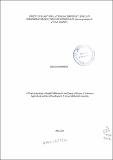| dc.description.abstract | Cleome gynandra has common names as African cabbage, spider flower, spider wisp, cat's whiskers which is an erect herbaceous biannual herb with hairy, often stems colour ranging from purple to cream and many branches growing to a height of about one meter. It is propagated by seed through sowing directly and thinning done four weeks after planting. It's an African leafy vegetable that is used as a vegetable and as a medicinal plant. It's known to play a key role in providing necessary nutrients such as iron, calcium, zinc, potassium, iodine and Magnesium for human development. It requires well drained loamy soils with an average rainfall of 1700 mm per year; the mean monthly maximum and minimum temperature requirement are 23.8°C and 12.4°C respectively. Farmers producing it, are often .faced with the challenge of which is the favorable spacing and fertilizer use, coupled with land fragmentation and declining soil fertility have resulted to spider plant persistently remaining low thus compromising food security and nutrition. Various recommendation of spacing have been given for the same crop by various extension service providers thus farmers planting ranging from conventional way to various recommendations given by various service providers, thus being prompted to study the effects of spacing / P levels on seed yield of spider plant in Vihiga County. Experimental design used was randomized complete block design with 3 replicates. Three plant spacing of 45 cm x 15 cm, 30 cm x 15 cm and broadcasting were used, subjected to five different levels of P20s ( 0, 20kg/ha, 30kg/ha, 40Kg/ha, 50Kg/ha). Ten plants per plot were randomly selected and tagged for data collection. The collected data were subjected to analysis of variance (ANOV A) tests using SPSS software. Means were compared using the least significant difference (LSD) test at 5% level of significance. Results indicated that plant height; number of branches, number of pods and seed yield were significantly affected by spacing and phosphorus levels. The wider spacing and highest level of P had significant effects on growth of plants and seed yield. The spacing 45 cm x 15 cm had a more positive effect on growth parameters and seeds weight as compared to other spacing (S1 = broadcasting, S2 = 30 cm x 15 cm). The phosphorus levels of F5 = 50kgs/ha, Fa = 40kgs/ha, F3 = 30kgs/ha and F2 = 20kg/ha had higher effect on growth and seed yield than the control (F1) by F5 registering much effects than the rest. Spacing of 45 cm x 15 cm with phosphorous level 50 kg/ha are recommended for optimal results in spider plant seed production. | en_US |

